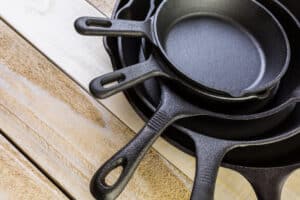
Spackle is a very useful and simple material for filling holes.
Homeowners with plaster or sheetrock often keep spackle around to make sure they can quickly fill a hole and paint their walls.
If you hung pictures on a wall and need to move them around, a quick drop of spackle and some paint can have the wall looking brand new again.
With how useful spackle is, you may wonder whether or not you can use it on wood.
If you have a hole in some wood at your home and you want to use spackle to fill it, we have everything you need to know.
Can You Use Spackle on Wood?

Spackle can be used on wood, and it can also be used on plaster, wallboard, and sometimes even masonry.
Spackle is a quick-acting and fast-drying product.
You will also be able to paint over spackle without having to do much to it.
If you have decided to use spackle on wood, there are some steps you are going to want to follow.
Steps for Using Spackle on Wood

When you use spackle on wood, you will want to make sure that you follow these steps.
If the spackle is not applied correctly, you may end up having it fall apart over time.
1. Prepare the Area
Before we spackle wood, we always sand the area a bit first.
Chances are you are going to be spackling over a rough area, and it needs to be smoothed out prior to applying the spackle to it.
Lightly sand the area and dust it off prior to moving to the next step.
2. Put Spackle in the Hole
Take some spackle out of your container and put it in the hole you want to fill.
It is best to use a putty knife when you do this if you want it to be a smooth fit.
Also, make sure that you are using a spackle that is suitable for use on wood.
If you are filling a hole outside, spackle may not be the best choice, and you may need something like Bondo to fill the hole.
If you try and fill the hole without the putty knife, you will likely leave yourself a very uneven surface.
In most cases, it is effortless to use the spackle and a putty knife to get a smooth surface on the wood.
Sometimes it is even easier to work with wood than it is with plaster or wall board.
3. Push Knife in Hole
In addition to smoothing the spackle, you are going to want to make sure it is being completely pushed into the hole.
If you simply place a layer of spackle over the top of the hole, it won’t be enough to keep the hole from collapsing in the future.
Once you have pushed it down and smoothed it out, you will need to let the spackle dry completely.
4. Sand Again to Prepare for Paint
Once the spackle is dry, you can then paint right over the surface.
If you notice that your spackle starts to break down or fall apart as you are sanding it, you may not have filled the hole properly.
If this is the case, you can fill the hole again and repeat the process.
What Is the Difference Between Wood Putty and Spackle?

If you were surprised that you could use spackle on wood, it might be because you are used to using wood putty.
Wood putty is specifically built for wood and filling holes in wood.
However, if you will be painting over a wood surface, you can use spackle, and it will work just fine.
Wood putty is a better choice, however, if you have a large hole in the wood.
What Is the Consistency of Wood Fillers and Putty?

Now that you understand that spackle and putty can sometimes be used interchangeably, it is good to understand the differences in the consistency of the material.
The thicker types of wood filler are used to fill larger holes, and they typically will have some types of sawdust and other materials mixed in.
These extra materials help to make sure the hole is filled with a more complete bond.
The thinner types of putty and wood filler are not going to do as good a job with filling larger holes, but they could work on smaller holes that you have in wood.
Make sure that you research the types of putty, filler, or spackle that you are using before you put them on the wood.
Also, remember that, when you are placing your finished project outside, it must be done with a material that can handle being outdoors.
When Would You Not Want to Use Spackle on Wood?

You may remember that we said it was perfectly acceptable to use spackle on wood if you were painting the wood.
The reason that you would not use spackle is if the wood needs to be stained.
When you stain wood, you will see where the spackle was applied almost immediately.
If you need to stain wood or you don’t want to stain it, and you want to keep it more natural, you need to use a putty or filler that is the same color as the wood.
Many of these putties can be purchased so that they match what you are already working with so that the wood grains can blend in with each other.
If you are a person who does quite a few DIY projects, it could be worth having a few different types of filler around in case you come across a project that needs it.
Why Do I Need to Use Exterior Filler on Some Wood Pieces?

When you start shopping for spackle or filler, you will notice that products will be labeled as being for interior use only or for interior and exterior use.
The interior use products expect that the temperature will remain about the same, and they also expect for there to be little to no moisture.
The exterior fillers are capable of handling situations where they may get wet or when the temperature variance is extreme.
Outdoor temperatures can get very hot and cold, and the filler or putty tends to expand and contract.
The materials that are rated for outdoor use are going to have more tolerance when it comes to these temperatures.
We highly recommend using something that is intended to be used outside as, otherwise, you will find yourself having to fill these holes continually.
If, however, you use an exterior filler on an interior piece, that is completely acceptable.
No harm will come from using the exterior filler indoors.
Most people will choose to purchase interior filler for indoor projects because it tends to be a little bit cheaper.
Anytime you start adding waterproof capabilities or extreme temperature tolerance, the price will increase a bit.
Having a smaller jar of filler that can work both outdoors and indoors seems to make the most sense.
How Long Does Spackle Take to Dry?

Depending on the type of spackle you use, it can be dry in about an hour, or it may take several hours.
If you know that you are in a hurry to complete your project, you may look for a quick-drying spackle to use.
We like to give the spackle a bit longer to set when using it on projects like holes in wood.
Since you likely had to apply the spackle a bit thickly in spots, you will probably need to give it some extra time to dry.
Giving the spackle the time to dry will help to make sure that it is fully set and filled before putting the final coat of paint on your wood.
Conclusion
Now that you have a better idea of what you can use spackle for, it’s time to get out and start completing some of your projects.
Always read the container of the product you are using to ensure that it is okay to use on wood.
Even though spackle is not always recommended, remember that painted wood will do just fine with spackle.
It’s important to remember that, if you are putting your finished piece of wood outside, you may be better off using a wood filler designed for outdoor use.
Overall, small holes in wood are easy to fix with a bit of spackle and a few minutes of your time.



Leave a Reply